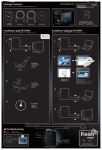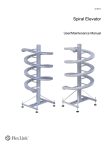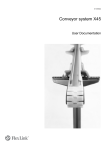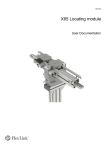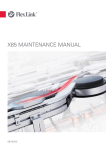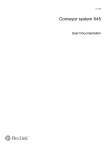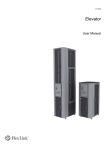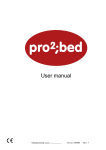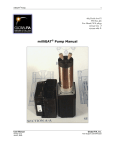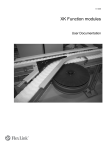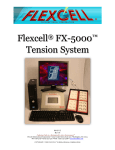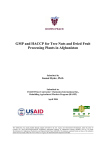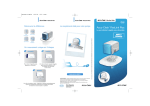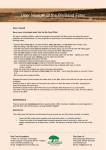Download MAINTENANCE MANUAL WLX
Transcript
MAINTENANCE MANUAL WLX WLX SYSTEM © Flexlink AB 2015 All Rights Reserved Created by EBCCW 00:06 No part of this program and manual may be used, reproduced, stored or transmitted in any form or by any means without the written permission of FlexLink AB. The contents of this manual are for informational use only. All information and specifications contained in this document have been carefully checked to the best efforts of FlexLink AB, and are believed to be true and accurate as of time of publishing. However, due to continued efforts in product development FlexLink AB reserves the right to modify products and its manuals without notice. FlexLink AB assumes no responsibility or liability on any errors or inaccuracies in this program or documentation. Any kind of material damages or other indirect consequences resulting from any FlexLink AB´s product part, documentation discrepancies and errors or non-anticipated program behaviour are limited to the value of appropriate products purchased from FlexLink AB. The products are delivered to the customer at the ’as is’ state and revision level they are on the moment of purchasing, and are declared in detail in the license agreements between FlexLink AB and user. User accepts and is obliged to follow the guidelines stated in the separate license agreement needed in using any parts of this product package. WLX System i ii WLX System 1 1.1 1.2 2 2.1 2.2 3 3.1 3.2 3.3 4 4.1 Created by EBCCW 00:06 System information Important safety conditions Maintenance System maintenance Maintenance instructions Inspection general Inspection checklist Corrective actions Change bearing house/sprocket Cleaning Guidelines 1 1 2 5 5 6 7 8 11 15 17 18 5 Typically cleaning process in wet applications 20 6 System dismantling and disposal 27 6.1 6.2 WLX System Safety Important safety precautions, dismantling Disposing 27 31 iii iv WLX System Safety 1 Safety The machine has been designed in such a way, that it can be used and maintained in a safe way. This holds for the application, the circumstances and the instructions described in the manual. Any person working with or on this machine should study the manual and follow the instructions. It is the responsibility of the employer to make sure that the employee is familiar with and follows these instructions. The company or the country in which the machine is used may require extra safety measures. This particularly applies to the working conditions. This manual does not describe how these are to be complied with. In case of doubt, consult your government or safety officer! 1.1 System information The project number and/or general drawing number shall always be specified when communicating with FlexLink with respect to the machine. Before handling the system, check safety around these areas. x2 Created by EBCCW 00:06 0 1 0 1 ! WLX System 1 Safety 1.2 Important safety conditions At the moment that the machine is going to be operated by a user, the following safety conditions must be met: • Make sure that children or animals have no access to the machine and its surrounding area by, for example, screening off the machine with a fence. • Only persons who have read and understood the operating instructions are allowed to operate, maintain and clean the machine. • Do not reach into the machine while it is running or on. Even if the machine is not running, it can be ‘on’, which means start operating automatically. • Safety provisions, such as side plating, bottom plating, emergency stops and detectors may not be removed or deactivated while the machine is running. • Provide good ambient lighting to enable the operator to work well and orderly with the machine. General . • Incorrect use of the equipment can cause personal injury. • Do not stand or climb on the equipment. • Do not wear clothing or other articles that can fasten in the machine. • Follow the instructions in this user manual when transporting the machine. FlexLink AB must approve all modifications or changes to this machine. • Only use recommended spare parts. • Only authorised personnel may open electrical units. • FlexLink is not responsible for damage if service on the equipment is not performed in accordance with this maintenance manual. Maintenance and Service technicians . 2 WLX System Safety Service technicians must have: • Sufficient knowledge for reading technical information • Ability to comprehend technical drawings • Basic knowledge of mechanics • Sufficient knowledge in the use of hand tools • Skilled (EN ISO 12100:2010) Electricians . Electricians must have: • Experience from similar installations • Sufficient knowledge to work from drawings and wiring diagrams • Knowledge of local safety regulations for electrical power and automation • Skilled (EN ISO 12100:2010) To avoid risks, only experienced personnel with technical knowledge and experience may perform repair work on the machine's electronics components. Operators . To correctly use the equipment, operators must have appropriate training and/or experience. Created by EBCCW 00:06 1 WLX System 3 Safety 4 WLX System Inspection general 3 Inspection general The inspection checklist have cross-references to other documents and refers to other chapters in present manual. 5.3 5.3 e.g. See chapter 5.3 in Engineering guidelines e.g. See chapter 5.3 in Assembly manual 5.1 e.g. Chapter 5.1 in present manual Created by EBCCW 00:06 ? WLX System 7 Inspection general 3.1 Inspection checklist 1 No jerky running 0 1 3.2.1 ? >8h ? No remarkable noise ? 3.2.2 ? Motor not overheated >70°C ? >70°C 3.2.3 No remarkable belt slack increase 3.2.4 ? 8 WLX System Inspection general 1 No high load in plain bend 3.2.5 Δ 20°C 0 Δ 20°C ? Correct return belt track guidance 1 ? No belt cracks or broken links 3.2.4 ? Motor securely fixed 5.5 Created by EBCCW 00:06 ? WLX System 9 Inspection general 1 0 1 No loosened conveyor screw connections ! ! ? Belt tensioner unit shaft securely locked x2 5.4 ? No remarkable belt slack increase 3.2.4 ? 10 WLX System Inspection general 3.2 3.2.1 Corrective actions Jerky running 1 ? ? 6.1 ! ? 7.3 5 Created by EBCCW 00:06 ? WLX System 11 Inspection general 3.2.2 Remarkable noise 1 ? ? 6.1 ! 3.3 ? kg? 3.0 kg kg ? 12 3.3 WLX System Inspection general 3.2.3 >70°C 0 0 Motor overheated 0 1 1 <70°C kg? 1 kg kg 0 1 ? ? 5.5 Created by EBCCW 00:06 0 WLX System >70°C 1 H2O 50°C 13 Inspection general 3.2.4 Shorten belt 1 7.2 3.2.5 High load on plain bend 1 0 0 1 1 m/min Δ 20°C kg? 3.0 kg kg FlexLink.com 14 ? WLX System Inspection general 3.3 Change bearing house/sprocket 1 ? 5.5 Created by EBCCW 00:06 x2 WLX System 15 Inspection general 1 ! x2 5,7 Nm 16 WLX System Maintenance 2 Maintenance 2.1 System maintenance 2.1.1 Introduction The following section is designed to offer assistance for your planned maintenance schedule. It may become evident that the suggested maintenance intervals can be shortened or extended to accommodate your local environmental conditions. Recommended maintenance every 1500 hour. Maintenance of the FlexLink conveyor systems should only be carried out by competent persons, who are familiar with FlexLink equipment. If there is any doubt as to the most suitable procedure for maintenance, consult your FlexLink supplier. 2.1.2 Non FlexLink equipment Equipment and components which are not from the FlexLink family of products should be maintained and serviced in accordance with their respective manufacturer’s instructions. 2.1.3 Safety considerations • Before starting any maintenance on your FlexLink equipment, the following safety instructions must be observed: • All electricity must be switched off. • Make sure that the motor switch is also switched off and locked in the “off” position. • Pneumatic and/or hydraulic power must be disconnected and any pressure accumulation released. • Products being transported should be, if possible, removed from the conveyor chain. • Staff affected must be informed that maintenance work is being undertaken. Created by EBCCW 00:06 Warning: Do not climb onto the equipment. WLX System 5 Maintenance 2.2 Maintenance instructions 2.2.1 Introduction This maintenance manual contains directions for the standard components sold through the WLX chapter of the FlexLink stainless steel catalogue. For non-FlexLink components, such as motors, pneumatic equipment, control systems etc., the manufacturer’s maintenance instructions apply. In general, maintenance instructions are not given for equipment which the customer has chosen and specified for fitting to the installation. The instructions supplied should be followed to ensure that the installation runs with a high degree of safety and to minimize the risk of breakdowns which can adversely affect the production. The installation must be used for the transport of goods in accordance with the system specifications or within design criteria as outlined in the stainless steel catalogue. If a fault occurs on the installation which cannot be rectified with the help of the instructions in the manual, or if unexpected conditions occur during servicing, contact your FlexLink retailer or FlexLink maintenance personnel. 2.2.2 Warranty/guarantee FlexLink conveyors are covered by warranty/guarantees as identified within the trading terms issued for each country. Check the warranty conditions for your system before submitting claims etc. If you are in any doubt as to what warranty is applicable to your system, consult your supplying agent or FlexLink direct. 2.2.3 Spare/replacement parts If there is a demand for spare parts, contact FlexLink or your supplying agent. 2.2.4 Inspection checklist A suggested maintenance inspection checklist is shown in next chapter. 2.2.5 Important Consult your system documentation for any special maintenance required for your specific installation. 1 6 WLX System Cleaning 4 Cleaning WLX system has an open design without compromising on safety. The system is designed to simplify cleaning/ inspection and to ensure consistent results for a safe food production. Created by EBCCW 00:06 In order to facilitate cleaning, the return belt is free hanging, the top belt can be lifted up and the outer slide rails can be folded back. Lifting arms (as shown in picture) can be supplied as an option. WLX System 17 Cleaning Idler end wheels have an open design and can easily be moved sideways in order to facilitate cleaning of the shaft. When conveyor belt is removed also drive sprockets can be moved sideways. 4.1 Guidelines Select correct cleaning chemicals in cooperation with the chemical supplier. Never overdose. Consequence can be corrosion on the conveyor and belt degradation. Recommendation is to clean the belt in place on conveyor in order to avoid recontamination during handling and belt reassembly. Run the conveyor and clean the belt as it goes around the sprockets. Stop the conveyor and use belt lifters to get access to the inside of the conveyor. NB: Note! Never run the conveyor when belt is lifted. The system must support a Lockout safety procedure. When using high pressure cleaning do not exceed 50 bar, 60 °C. Sanitizer containing chlorine should not exceed 200 ppm chlorine. Plastic conveyor parts and especially Belts shall not be exposed for chlorine based fluids for a longer period. Consequence is brittleness and discoloration of the plastic. 18 WLX System Cleaning POM PP PA PE PU PK PBT Polypropylene Polyamide Polyethylene Polyurethane Polyketone Polybutylene Terephthalate Material Polyoximetylen Plastic material resistance for different types of cleaning agents (Parameters such as concentration, temperature, exposure time influence the resistance. Follow the chemical supplier recommendations.) Type of agent Neutral Alkaline Acid Chlorine Item Modular belt, radius flush grid Modular belt, Friction top belt Flat top belt Slide rails (core/sliding material) Belt guides (for return belt) Steering guides (drive, idler) Sprockets, idler wheels (drive, idler, belt tensioner unit) Guide blocks for shaft, Belt tensioner unit Locking device, Belt tensioner unit Bearing housing Created by EBCCW 00:06 Bearing end cap resistant WLX System conditionally resistant 19 Typically cleaning process in wet applications 5 Typically cleaning process in wet applications Step 1 – Preparation – switch off electrics etc. Step 2 – Gross solid removal 20 WLX System Typically cleaning process in wet applications Step 3 – Pre-rinsing Max. 25 bar Max. 60°C With pre-rinsing, coarse dirt is rinsed off or detached with warm water (up to 60°C) at low (max. 25 bar) pressure (high pressure causes increased aerosol formation –> recontamination, moreover, material exposed to high pressure is subject to excessive stress). Created by EBCCW 00:06 Step 4 – Lift belt WLX System 21 Typically cleaning process in wet applications Step 5 – Cleaning Apply washing powder max. 20 min Max. 25 bar Max. 60°C At the actual main cleaning stage, stubborn dirt on the belt (e.g. oils and fats) is dissolved with the aid of chemical cleaning agents. Cleaning agents are generally applied as foam. In practice, however, under certain circumstances the belt is also scrubbed manually. Step 6 – Rinsing off In this stage, dirt previously detached or dissolved is rinsed off the belt with the aid of warm water (up to 60 °C/140 °F) and low pressure. It is particularly important not to set the water pressure too high so that when rinsing off the conveyor belt neighboring machinery, plant components, walls or floors are not contaminated again by splashes of material which has just been washed off (cross contamination). 22 WLX System Typically cleaning process in wet applications Max. 25 bar Max. 60°C Step 7 – Check cleaning result Created by EBCCW 00:06 Check all critical areas, e. g. visually or by ATP-measurement. Re-clean if necessary. WLX System 23 Typically cleaning process in wet applications Step 8 – Disinfecting Disinfection is recommended in all hygiene relevant areas of a food processing plant such as production equipment, conveyor belts, packaging machines, facilities, floors, walls and all areas identified within the existing HACCP-system. It should always be taken into consideration that also surfaces without direct food contact could cause hygiene risks in regard to cross- contamination. Moreover, the conveyor belt must not be affected by cleaning agents and disinfectants. Therefore, note should be taken of the chemical resistance of the plastic, the directions for use and the dosage instructions of the chemicals used. 24 WLX System Typically cleaning process in wet applications Step 9 – Final rinsing off with POTABLE water Max. 25 bar Max. 60°C After cleaning, and if required, the conveyor belt is rinsed off with potable water using low pressure. (All residues from cleaning agents or disinfectants should be removed from the belt before it is used again.) Created by EBCCW 00:06 Step 10 – Check Disinfection result is checked using the appropriate method for the particular industrial sector (e. g. microbiological method: swab, contact plate). WLX System 25 Typically cleaning process in wet applications 26 WLX System System dismantling and disposal 6 System dismantling and disposal 6.1 Important safety precautions when dismantling Dismantling of the FlexLink conveyor system should be carried out by competent persons, who are familiar with the equipment being decommissioned. In the absence of detailed information, every care should be taken to ensure that all items are securely retained during the decommissioning process. This is to ensure that the equipment remains stable and will not fall if left unattended. With regard to the environment, you should separate the plastic, motor and stainless steel when you disassemble the system. Created by EBCCW 00:06 If there are any doubts as to the most suitable procedure for decommissioning, then consult the equipment supplier. WLX System 27 System dismantling and disposal 6.1.1 Dismantle a WLX Conveyor system 1 To dismantle a FlexLink conveyor the following tools are required. 10 mm 13 mm 15 mm 28 Snap ring pliers 10 mm T30 2 Remove any remaining product from the conveyor system. 3 Switch off all electrical power. Ensure that system is safe by shutting down all feed supplies or removing electrical fuses. WLX System System dismantling and disposal 4 Remove motor 5.5 5 Remove guide rails and guide rail brackets etc 8.1 6 Remove Modular belt Created by EBCCW 00:06 7.3 WLX System 29 System dismantling and disposal 7 Remove Slide rails and Belt guides. 6.1 8 Remove Drive units and Idler end units 5.5 9 Remove Beams from Support legs. 5.1 kg 30 WLX System System dismantling and disposal 6.2 Disposing Sort different materials ready for disposal. 1 POM PP PA PE PU PK PBT Polypropylene Polyamide Polyethylene Polyurethane Polyketone Polybutylene Terephthalate Material Polyoximetylen Most material in the WLX system are stainless steel. Separate stainless steel, plastic and the motor. This table shows the different plastics to be disposal. Modular belt, radius flush grid Modular belt, Friction top belt Flat top belt Slide rails (core/sliding material) Belt guides (for return belt) Steering guides (drive, idler) Sprockets, idler wheels (drive, idler, belt tensioner unit) Guide blocks for shaft, Belt tensioner unit Locking device, Belt tensioner unit Bearing housing Created by EBCCW 00:06 Bearing end cap WLX System 31 System dismantling and disposal 32 WLX System Created by EBCCW 00:06 WLX System 1 2 Publication 5853EN-1 2015-02 WLX System








































